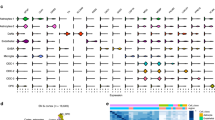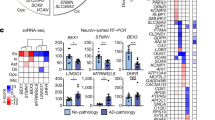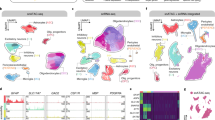Abstract
Age is the primary risk factor for Parkinson’s disease (PD), but how aging changes the expression and regulatory landscape of the brain remains unclear. Here we present a single-nuclei multiomic study profiling shared gene expression and chromatin accessibility of young, aged and PD postmortem midbrain samples. Combined multiomic analysis along a pseudopathogenesis trajectory reveals that all glial cell types are affected by age, but microglia and oligodendrocytes are further altered in PD. We present evidence for a disease-associated oligodendrocyte subtype and identify genes lost over the aging and disease process, including CARNS1, that may predispose healthy cells to develop a disease-associated phenotype. Surprisingly, we found that chromatin accessibility changed little over aging or PD within the same cell types. Peak–gene association patterns, however, are substantially altered during aging and PD, identifying cell-type-specific chromosomal loci that contain PD-associated single-nucleotide polymorphisms. Our study suggests a previously undescribed role for oligodendrocytes in aging and PD.
This is a preview of subscription content, access via your institution
Access options
Access Nature and 54 other Nature Portfolio journals
Get Nature+, our best-value online-access subscription
$29.99 / 30 days
cancel any time
Subscribe to this journal
Receive 12 digital issues and online access to articles
$119.00 per year
only $9.92 per issue
Buy this article
- Purchase on Springer Link
- Instant access to full article PDF
Prices may be subject to local taxes which are calculated during checkout







Similar content being viewed by others
Data availability
Processed data for the samples presented in this study are available in the Gene Expression Omnibus database under accession number GSE193688. Raw data are available through the dbGaP portal under accession number phs002819.v1.p1. snRNA-seq and ATAC-seq reads were mapped to GRCh38 human reference (https://www.ncbi.nlm.nih.gov/datasets/genome/GCF_000001405.26/).
References
Parkinsonʼs Foundation. Statistics. https://www.parkinson.org/understanding-parkinsons/statistics
Pringsheim, T., Jette, N., Frolkis, A. & Steeves, T. D. The prevalence of Parkinson’s disease: a systematic review and meta-analysis. Mov. Disord. 29, 1583–1590 (2014).
Dauer, W. & Przedborski, S. Parkinson’s disease: mechanisms and models. Neuron 39, 889–909 (2003).
Hindle, J. V. Ageing, neurodegeneration and Parkinson’s disease. Age Ageing 39, 156–161 (2010).
Davie, K. et al. A single-cell transcriptome atlas of the aging Drosophila brain. Cell 174, 982–998 (2018).
Ximerakis, M. et al. Single-cell transcriptomic profiling of the aging mouse brain. Nat. Neurosci. 22, 1696–1708 (2019).
Glaab, E. & Schneider, R. Comparative pathway and network analysis of brain transcriptome changes during adult aging and in Parkinson’s disease. Neurobiol. Dis. 74, 1–13 (2015).
Ma, S. et al. Chromatin potential identified by shared single-cell profiling of RNA and chromatin. Cell 183, 1103–1116 (2020).
Mathys, H. et al. Single-cell transcriptomic analysis of Alzheimer’s disease. Nature 570, 332–337 (2019).
Nott, A. et al. Brain cell type-specific enhancer–promoter interactome maps and disease–risk association. Science 366, 1134–1139 (2019).
Agarwal, D. et al. A single-cell atlas of the human substantia nigra reveals cell-specific pathways associated with neurological disorders. Nat. Commun. 11, 4183 (2020).
Bryois, J. et al. Genetic identification of cell types underlying brain complex traits yields insights into the etiology of Parkinson’s disease. Nat. Genet. 52, 482–493 (2020).
Reynolds, R. H. et al. Moving beyond neurons: the role of cell type-specific gene regulation in Parkinson’s disease heritability. NPJ Parkinsons Dis. 5, 6 (2019).
Smajic, S. et al. Single-cell sequencing of human midbrain reveals glial activation and a Parkinson-specific neuronal state. Brain 145, 964–978 (2021).
Braak, H. & Del Tredici, K. Poor and protracted myelination as a contributory factor to neurodegenerative disorders. Neurobiol. Aging 25, 19–23 (2004).
Hao, Y. et al. Integrated analysis of multimodal single-cell data. Cell 184, 3573–3587 (2021).
Cakir, B. et al. Engineering of human brain organoids with a functional vascular-like system. Nat. Methods 16, 1169–1175 (2019).
Tanaka, Y., Cakir, B., Xiang, Y., Sullivan, G. J. & Park, I. H. Synthetic analyses of single-cell transcriptomes from multiple brain organoids and fetal brain. Cell Rep. 30, 1682–1689 (2020).
Morabito, S. et al. Single-nucleus chromatin accessibility and transcriptomic characterization of Alzheimer’s disease. Nat. Genet. 53, 1143–1155 (2021).
Borras, C. et al. RasGrf1 deficiency delays aging in mice. Aging (Albany NY) 3, 262–276 (2011).
Salmon, A. B. et al. Effects of transgenic methionine sulfoxide reductase A (MsrA) expression on lifespan and age-dependent changes in metabolic function in mice. Redox Biol. 10, 251–256 (2016).
Duclot, F. & Kabbaj, M. The role of early growth response 1 (EGR1) in brain plasticity and neuropsychiatric disorders. Front. Behav. Neurosci. 11, 35 (2017).
Kim, E. J., Ables, J. L., Dickel, L. K., Eisch, A. J. & Johnson, J. E. Ascl1 (Mash1) defines cells with long-term neurogenic potential in subgranular and subventricular zones in adult mouse brain. PLoS ONE 6, e18472 (2011).
Sandberg, M., Patil, J., D’Angelo, B., Weber, S. G. & Mallard, C. NRF2-regulation in brain health and disease: implication of cerebral inflammation. Neuropharmacology 79, 298–306 (2014).
Corces, M. R. et al. Single-cell epigenomic analyses implicate candidate causal variants at inherited risk loci for Alzheimer’s and Parkinson’s diseases. Nat. Genet. 52, 1158–1168 (2020).
Bulik-Sullivan, B. K. et al. LD Score regression distinguishes confounding from polygenicity in genome-wide association studies. Nat. Genet. 47, 291–295 (2015).
Galatro, T. F. et al. Transcriptomic analysis of purified human cortical microglia reveals age-associated changes. Nat. Neurosci. 20, 1162–1171 (2017).
Habib, N. et al. Disease-associated astrocytes in Alzheimer’s disease and aging. Nat. Neurosci. 23, 701–706 (2020).
Jakel, S. et al. Altered human oligodendrocyte heterogeneity in multiple sclerosis. Nature 566, 543–547 (2019).
Keren-Shaul, H. et al. A unique microglia type associated with restricting development of Alzheimer’s disease. Cell 169, 1276–1290 (2017).
Liddelow, S. A. et al. Neurotoxic reactive astrocytes are induced by activated microglia. Nature 541, 481–487 (2017).
Marques, S. et al. Oligodendrocyte heterogeneity in the mouse juvenile and adult central nervous system. Science 352, 1326–1329 (2016).
Teeple, E. et al. Single nuclei sequencing of human putamen oligodendrocytes reveals altered heterogeneity and disease-associated changes in Parkinson’s disease and multiple system atrophy. Preprint at bioRxiv https://doi.org/10.1101/2021.05.06.442967 (2021).
Escartin, C. et al. Reactive astrocyte nomenclature, definitions, and future directions. Nat. Neurosci. 24, 312–325 (2021).
Cao, J. et al. The single-cell transcriptional landscape of mammalian organogenesis. Nature 566, 496–502 (2019).
Ameijeiras-Alonso, J., Crujeiras, R. M. & Rodriguez-Casal, A. multimode: an R package for mode assessment. J. Stat. Softw. 97, 1–32 (2021).
Hipkiss, A. R. Glycotoxins: dietary and metabolic origins; possible amelioration of neurotoxicity by carnosine, with special reference to Parkinson’s disease. Neurotox. Res. 34, 164–172 (2018).
Kubota, M. et al. Carnosine suppresses neuronal cell death and inflammation induced by 6-hydroxydopamine in an in vitro model of Parkinson’s disease. PLoS ONE 15, e0240448 (2020).
Stuart, T. et al. Comprehensive integration of single-cell data. Cell 177, 1888–1902 (2019).
Xiang, Y. et al. Fusion of regionally specified hPSC-derived organoids models human brain development and interneuron migration. Cell Stem Cell 21, 383–398 (2017).
Amemiya, H. M., Kundaje, A. & Boyle, A. P. The ENCODE blacklist: identification of problematic regions of the genome. Sci. Rep. 9, 9354 (2019).
Xiang, Y. et al. Dysregulation of BRD4 function underlies the functional abnormalities of MeCP2 mutant neurons. Mol. Cell 79, 84–98 (2020).
Falcon, S. & Gentleman, R. Using GOstats to test gene lists for GO term association. Bioinformatics 23, 257–258 (2007).
Korsunsky, I. et al. Fast, sensitive and accurate integration of single-cell data with Harmony. Nat. Methods 16, 1289–1296 (2019).
Lawrence, M. et al. Software for computing and annotating genomic ranges. PLoS Comput. Biol. 9, e1003118 (2013).
Stuart, T., Srivastava, A., Madad, S., Lareau, C. A. & Satija, R. Single-cell chromatin state analysis with Signac. Nat Methods 18, 1333–1341 (2021).
Heinz, S. et al. Simple combinations of lineage-determining transcription factors prime cis-regulatory elements required for macrophage and B cell identities. Mol. Cell 38, 576–589 (2010).
Al-Dalahmah, O. et al. Single-nucleus RNA-seq identifies Huntington disease astrocyte states. Acta Neuropathol. Commun. 8, 19 (2020).
Baldo, B. et al. A screen for enhancers of clearance identifies huntingtin as a heat shock protein 90 (Hsp90) client protein. J. Biol. Chem. 287, 1406–1414 (2012).
Barry, G. et al. The long non-coding RNA NEAT1 is responsive to neuronal activity and is associated with hyperexcitability states. Sci. Rep. 7, 40127 (2017).
Barry, G., Guennewig, B., Fung, S., Kaczorowski, D. & Weickert, C. S. Long non-coding RNA expression during aging in the human subependymal zone. Front. Neurol. 6, 45 (2015).
Binder, E. B. et al. Polymorphisms in FKBP5 are associated with increased recurrence of depressive episodes and rapid response to antidepressant treatment. Nat. Genet. 36, 1319–1325 (2004).
Blair, L. J. et al. Accelerated neurodegeneration through chaperone-mediated oligomerization of tau. J. Clin. Invest. 123, 4158–4169 (2013).
Chang, L. C. et al. A conserved BDNF, glutamate- and GABA-enriched gene module related to human depression identified by coexpression meta-analysis and DNA variant genome-wide association studies. PLoS ONE 9, e90980 (2014).
Evers, M., Cunningham-Rundles, C. & Hollander, E. Heat shock protein 90 antibodies in autism. Mol. Psychiatry 7, S26–S28 (2002).
Karis, K. et al. Altered expression profile of IgLON family of neural cell adhesion molecules in the dorsolateral prefrontal cortex of schizophrenic patients. Front. Mol. Neurosci. 11, 8 (2018).
Katsel, P. et al. The expression of long noncoding RNA NEAT1 is reduced in schizophrenia and modulates oligodendrocytes transcription. NPJ Schizophr. 5, 3 (2019).
Kim, J. J. et al. Identification of antibodies to heat shock proteins 90 kDa and 70 kDa in patients with schizophrenia. Schizophr. Res. 52, 127–135 (2001).
Labadorf, A. et al. RNA sequence analysis of human Huntington disease brain reveals an extensive increase in inflammatory and developmental gene expression. PLoS ONE 10, e0143563 (2015).
Lee, C. H. et al. Heat shock protein 90 and its cochaperone, p23, are markedly increased in the aged gerbil hippocampus. Exp. Gerontol. 46, 768–772 (2011).
Liu, Y. & Lu, Z. Long non-coding RNA NEAT1 mediates the toxic of Parkinson’s disease induced by MPTP/MPP+ via regulation of gene expression. Clin. Exp. Pharmacol. Physiol. 45, 841–848 (2018).
Maccarrone, G. et al. Psychiatric patient stratification using biosignatures based on cerebrospinal fluid protein expression clusters. J. Psychiatr. Res. 47, 1572–1580 (2013).
Mariani, E. et al. Meta-analysis of Parkinson’s disease transcriptome data using TRAM software: whole substantia nigra tissue and single dopamine neuron differential gene expression. PLoS ONE 11, e0161567 (2016).
Patel, H. et al. Transcriptomic analysis of probable asymptomatic and symptomatic alzheimer brains. Brain Behav. Immun. 80, 644–656 (2019).
Patel, N., Crider, A., Pandya, C. D., Ahmed, A. O. & Pillai, A. Altered mRNA levels of glucocorticoid receptor, mineralocorticoid receptor, and co-chaperones (FKBP5 and PTGES3) in the middle frontal gyrus of autism spectrum disorder subjects. Mol. Neurobiol 53, 2090–2099 (2016).
Sha, L. et al. Pharmacologic inhibition of Hsp90 to prevent GLT-1 degradation as an effective therapy for epilepsy. J. Exp. Med. 214, 547–563 (2017).
Sinclair, D., Fillman, S. G., Webster, M. J. & Weickert, C. S. Dysregulation of glucocorticoid receptor co-factors FKBP5, BAG1 and PTGES3 in prefrontal cortex in psychotic illness. Sci. Rep. 3, 3539 (2013).
Sunwoo, J. S. et al. Altered expression of the long noncoding RNA NEAT1 in Huntington’s disease. Mol. Neurobiol. 54, 1577–1586 (2017).
Uryu, K. et al. Convergence of heat shock protein 90 with ubiquitin in filamentous α-synuclein inclusions of α-synucleinopathies. Am. J. Pathol. 168, 947–961 (2006).
Woo, J. A. et al. Enhanced tau pathology via RanBP9 and Hsp90/Hsc70 chaperone complexes. Hum. Mol. Genet. 26, 3973–3988 (2017).
Zhao, M. Y. et al. The long-non-coding RNA NEAT1 is a novel target for Alzheimer’s disease progression via miR-124/BACE1 axis. Neurol. Res. 41, 489–497 (2019).
Pinero, J. et al. DisGeNET: a discovery platform for the dynamical exploration of human diseases and their genes. Database (Oxford) 2015, bav028 (2015).
Quinlan, A. R. & Hall, I. M. BEDTools: a flexible suite of utilities for comparing genomic features. Bioinformatics 26, 841–842 (2010).
Acknowledgements
The authors gratefully acknowledge the National Institutes of Health (NIH) NeuroBioBank for providing all postmortem brain samples. They also thank A. Knott for language editing. This study was supported by NIH 1R01-NS100919 and 1R01-NS101461 (to Y.-S.K), by startup funds from the Centre de recherche de l’Hôpital Maisonneuve-Rosemont, Université de Montréal (to Y.T), by Fonds de recherche du Québec–Santé (to Y.T) and by a transition grant from the Cole Foundation (to Y.T). The funders had no role in study design, data collection and analysis, decision to publish or preparation of the manuscript.
Author information
Authors and Affiliations
Contributions
L.A. and Y.-S.K. designed the study. Nuclear isolation and library preparation were performed by L.A. and M.S. Computational analysis was performed by Y.T., S.Y. and L.A. L.A., Y.-S.K. and Y.T. wrote the manuscript. All authors contributed to the review and revision of the manuscript.
Corresponding authors
Ethics declarations
Competing interests
Y.T. works as a consultant in Colossal Biosciences. The other authors declare no competing interests.
Peer review
Peer review information
Nature Aging thanks Qin Ma and the other, anonymous, reviewer(s) for their contribution to the peer review of this work.
Additional information
Publisher’s note Springer Nature remains neutral with regard to jurisdictional claims in published maps and institutional affiliations.
Extended data
Extended Data Fig. 1 Multiomic analysis of human midbrain.
a, UMAP visualization of single nuclei by RNA (left) and ATAC (right) profiles. Nuclei are colored by 23 joint clusters. b, Heatmap showing Spearman correlation of average RNA expression (left) and ATAC peaks profiles (right) by cell types for each individual. Top and second color bars represent groups of donors and cell types, respectively. c, Enrichment of motifs in each annotated cell type.
Extended Data Fig. 2 Changes in peak-gene connections in young, aged, and PD for NEAT1 and RASGRF1.
a,b, Venn diagram of the number of associated peaks with NEAT1 (a) and RASGRF1 (b) for young, aged, and PD midbrain. c,d, Heatmap showing enrichment of TF binding motifs in associated peaks with NEAT1 (c) and RASGRF1 (d). e, Comparison of peak-gene association detected in our samples with H3K27ac HiChIP data from the human midbrain (Morabito et al.19) near the FKBP5 locus.
Extended Data Fig. 3 Different distribution of PD-associated SNPs within ATAC peaks across cell types.
a, Number of PD-related SNPs is shown on the ideogram in each cell type. (blue, 1; purple, 2; green, 3; orange, 5; red, 7 SNPs) b, Differential peak-gene associations in astrocytes across PD patients and healthy young and aged donors. Whereas the ATAC peak on the BST1 locus is commonly detected in PD patients and healthy donors, the peak-gene associations are different between PD patients and healthy donors. This ATAC peak contains three PD-related SNPs.
Extended Data Fig. 4 cPP analysis of ODC.
a-c, Dot plot displaying enrichment of gene expression modules for functionally distinct subpopulations for ODC (a), MG (b), and AS (c) clusters in the human midbrain. d, Example genes that have a correlated increase (HSP90AA1) and decrease (CTNNA3) of expression with cPP trajectory. e, Plot of expression of NEAT1 and RASGRF1 across cPP trajectory. NEAT1 expression is correlated with increasing cPP score; RASGRF1 expression is inversely correlated with cPP score (NEAT1: Spearman correlation = 0.314, p < 2.2e-16, RASGRF1: Spearman correlation = −0.110, p < 2.2e-16). Black line indicates loess-smoothed curve, and the gray outline represents 95% CI. f, UMAP of RBFOX1 and OPALIN and their coexpressed genes are mutually exclusive in ODC. g, Expression plot of RBFOX1 and OPALIN across cPP trajectory. n = 15,192 (Young), 11,973 (Aged), and 18,415 (PD). h, Dot plot of gene expression for RBFOX1 and OPALIN in each donor cohort.
Extended Data Fig. 5 Establishment of pseudopathogenesis trajectory in AS.
a, UMAP plot of AS nuclei colored by subclusters b, UMAP plot of AS nuclei colored by young, aged, and PD donor. c, UMAP plot of AS nuclei colored by cPP. d, cPP scores of individual AS nuclei from young, aged, and PD midbrain are significantly changed over aging but not a disease state. (One-way ANOVA with Tukey’s post-hoc analysis, p-value for Y/A = 0.002, p-value for Y/P = 5.28e-4, p-value for A/P = 0.24). p-values are represented as ** p < 0.01 and *** p < 0.001. e, Heatmap showing AS genes correlated with cPP trajectory. X-axis represents individual cells sorted by cPP. Y-axis of heatmap represents positively (upper)- and negatively (bottom)-correlated genes. Representative genes and significant GO terms are shown in the right panel (Spearman correlation > 0.1 or < −0.1).n = 999 (Young), 397 (Aged), and 1,032 (PD). The bottom, center, and top of the box represent 25, 50, and 75 percentile. Whiskers represent 1.5 × IQR. f, Gene expression modules across AS cPP trajectory. Top panel shows individual nuclei AS along with cPP scores and donor group. X-axis shows the cPP score. Y-axis is the combined expression level for all genes in the expression module. Black line indicates loess-smoothed curve, and the gray outline represents 95% CI.
Extended Data Fig. 6 Aging- and disease-specific analysis.
a, Violin plot of cPP score of every individual ODC nuclei by donor. b, Bar graph showing the percentage of nuclei in donor cohort from healthy, intermediate, and disease groups. c, UMAP showing healthy, intermediate, and disease subsets from publicly available snRNA-seq data (Smajić et al, 2022) from the human PD and aged control midbrain after pseudopathogenesis analysis. d, Dot plots of genes from the same dataset (Smajić et al, 2022) showing similar expression patterns among healthy, intermediate, and disease subsets as our multiomic dataset. Circle size represents relative gene expression to healthy subsets. e,f, Representative peak-gene connection plots for peaks containing PD-associated SNPs that have decreased (e) or increased (f) gene connections in disease-associated ODC compared to healthy ones. Motif information was obtained from the JASPAR Transcription Factors track in the UCSC genome browser. SNPs associated with each peak are shown below.
Supplementary information
Rights and permissions
Springer Nature or its licensor (e.g. a society or other partner) holds exclusive rights to this article under a publishing agreement with the author(s) or other rightsholder(s); author self-archiving of the accepted manuscript version of this article is solely governed by the terms of such publishing agreement and applicable law.
About this article
Cite this article
Adams, L., Song, M.K., Yuen, S. et al. A single-nuclei paired multiomic analysis of the human midbrain reveals age- and Parkinson’s disease–associated glial changes. Nat Aging 4, 364–378 (2024). https://doi.org/10.1038/s43587-024-00583-6
Received:
Accepted:
Published:
Issue Date:
DOI: https://doi.org/10.1038/s43587-024-00583-6



